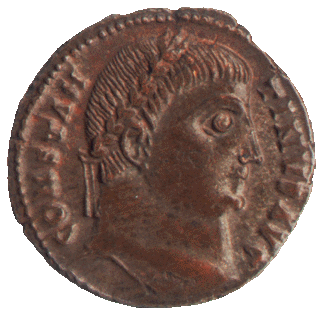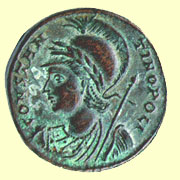 Contents -
Previous Article -
Next Article
Contents -
Previous Article -
Next Article
Emperor Constantine I (The Great)
Roman Emperor A. D. 306 - 337
Dominate Period
Constantine is one of the best known of the Roman Emperors. Some important events of his reign included the issuance of the Edict of Milan, which ended the persecution of Christians and made their worship legal, the battle of the Milvian Bridge, and the completion of the political and economic reforms begun under Diocletian. Constantine was also important in the history of the Catholic Church for his role at the Council of Nicaea, where important points of faith in the early Catholic Church dealing with the Holy Trinity were worked out. He increased the role of the Catholic Church in the Roman government by placing bishops in high political office, where they soon became quite powerful. Constantine was baptized on his deathbed, the first Roman emperor to receive the Christian faith. One of the famous stories told about Constantine is that of his vision from God on the night before the battle of the Milvian Bridge. Maxentius, the Roman emperor in Italy, had gathered a great number of legions in defiance of Constantine. Galerius had decided to tax the citizens of Italy, who had been exempt from taxes ever since Republican days. Naturally, the Italian citizens resented this and proclaimed Maxentius emperor in an effort to get the odious taxes removed. Constantine was not at all sure of his chances of victory. According to legend, Constantine saw the symbol of Jesus Christ’s power in the clouds and a message written in Latin reading IN HOC SIGNO VINCES, meaning "In this sign shalt thou conquer." Immediately, Constantine placed the sign of Christ on his standards and had it painted on his shields. Constantine won the day with a decisive victory and Maxentius, thrown from the Milvian Bridge, was drowned when the weight of his armor caused him to sink into the mud and ooze at the bottom of the River Tiber. His body was recovered the day after the battle.
One of the most famous Roman emperors might never have ascended the throne if he hadn’t taken a wild ride one night, fleeing for his life from the "protection" of his "guardian." Constantine, then about thirty years old, was very popular with the legions and had a good military record. Furthermore, he was the son of Constantius Chlorus, the Roman emperor in the West. Constantius was preparing for a military campaign against the wild painted Picts north of Hadrian's Wall in Britain and wanted his son with him to help lead his legions. Constantius asked the Eastern emperor Galerius to send the young man to him. Galerius was reluctant to let the young man go to his father, where his popularity with the army might undermine Galerius' authority. It was less than a decade since the island had been wrested from the grip of the two usurpers Carausius and his successor Allectus. The memory of these past events and the dangerous example they set for the future were too fresh in the mind of the powerful Eastern emperor for him to be comfortable allowing such a well-liked military leader out of his sight. When Galerius grudgingly gave his permission, Constantine immediately took a few followers and swiftly fled by night on fast horses. Thanks to the excellent Roman military roads, they were on the coast of France boarding his father's ships before Galerius could change his mind and have the popular young man pursued and recalled. Galerius' fears were soon to be confirmed. When Constantius Chlorus became ill and died at the Roman military center of York in A. D. 306, the British troops immediately proclaimed Constantine emperor of Britain. Galerius was enraged, but Constantine quickly wrote to tell him that the whole idea was concocted by the troops and that he, Constantine, had had nothing to do with it. Since Constantine was far away and supported by an army, Galerius relented and agreed to give him the title of Caesar and raise another man, Severus II, to the rank of Augustus in the West to replace Constantius Chlorus.
A few months later, the citizens of Italy rebelled and named Maxentius, the popular son of Maximianus their emperor. Galerius had increased their taxes and had removed the tax-exempt status Rome had enjoyed since the days of the Republic. Maxentius then invited his father to come out of retirement and rejoin him as co-emperor. Soon the two rebels were joined by Constantine, who was again claiming the title of Augustus. Galerius sent Severus II to deal with the rebels but Severus was defeated and later put to death by Maximianus. Things had gotten so bad by this time that the Roman Empire was in danger of returning to the anarchy and civil war of the Third Century Diocletian agreed to come out of retirement himself and chair a peace conference at the military town of Carnuntum on the Danube. According to the agreement, Constantine was to be demoted to the rank of Caesar and Valerius Licinianus Licinius was made Augustus in the West.. Additionally, Maximianus was forced again to abdicate and Maxentius was declared an enemy of the people.
The final showdown with Maxentius came in A. D. 312 at the Milvian Bridge. Constantine made an alliance with Licinius in order to bring more troops against his rival, and easily won the battle in which Maxentius was killed. After Constantine's victory over Maxentius, Constantine and Licinius were left in joint control of the vast Roman Empire. In A. D. 317, Constantine's sons Crispus and Constantine II and Licinius' son Licinius II were appointed Caesars.
The strong-willed, power seeking personalities of both Constantine and Licinius virtually ensured there would be trouble between the two rulers. From 312 to 324, relations between the Augusti steadily deteriorated. Finally, war broke out between the two over an incident in which Licinius chased some raiding barbarians into territory ruled by Constantine. Constantine defeated Licinius in two battles at Hadrianopolis and Chrysopolis. Though Constantine spared both Licinius and his son, they were soon plotting against Constantine to regain their thrones. Constantine had both of them put to death.
 Soon after Constantine had defeated Licinius, he began work on the ancient Greek city of Byzantium to transform it into his new Capital of the East. Six years later, on May 11, A. D. 330. the beautiful new city of Constantinopolis, or Constantinople to the modern reader, was dedicated. Coins like the one at right showing the helmeted personnification of Constantinople were struck to commemorate the joyous event.
Soon after Constantine had defeated Licinius, he began work on the ancient Greek city of Byzantium to transform it into his new Capital of the East. Six years later, on May 11, A. D. 330. the beautiful new city of Constantinopolis, or Constantinople to the modern reader, was dedicated. Coins like the one at right showing the helmeted personnification of Constantinople were struck to commemorate the joyous event.
In A. D. 325, Constantine presided over the Council of Nicaea. Bishops from all over the Roman world gathered together to have Constantine help them decide on the nature of God. They worked out the doctrine of the Holy Trinity, in which Father, Son, and Holy Ghost were found to be equal persons in one God. Also, the Arian heresy was denounced at the Council of Nicaea. The Arians believed that Jesus Christ was somehow of a lesser importance, and had been created by, God the Father.
Two years later, dark intrigue and tragedy struck the house of Constantine. Constantine’s wife, Fausta, had accused Constantine's eldest son Crispus of adultery with her and plotting to seize the throne. Without checking the truth of these accusations, Constantine had his son murdered. It is thought that she made the accusation in order to place one of her own sons in line for the throne, as Crispus was Constantine's son by a previous marriage. When Constantine discovered that he had been lied to, he had Fausta suffocated or boiled alive in her bath by slowly running up the temperature of the water.
Constantine died at Nicomedia on May 22, 337. It is believed that he was baptized a Christian on his deathbed. After his death, his two nephews, Hanniballianus and Delmatius were put to death in the ensuing struggle for power. Both had been made caesars a few years before.
Go to next article on Maxentius
Go back to previous article on Maximinus II (Daia)
Return to Roman Emperors Table of Contents
 Soon after Constantine had defeated Licinius, he began work on the ancient Greek city of Byzantium to transform it into his new Capital of the East. Six years later, on May 11, A. D. 330. the beautiful new city of Constantinopolis, or Constantinople to the modern reader, was dedicated. Coins like the one at right showing the helmeted personnification of Constantinople were struck to commemorate the joyous event.
Soon after Constantine had defeated Licinius, he began work on the ancient Greek city of Byzantium to transform it into his new Capital of the East. Six years later, on May 11, A. D. 330. the beautiful new city of Constantinopolis, or Constantinople to the modern reader, was dedicated. Coins like the one at right showing the helmeted personnification of Constantinople were struck to commemorate the joyous event.
 Contents -
Previous Article -
Next Article
Contents -
Previous Article -
Next Article